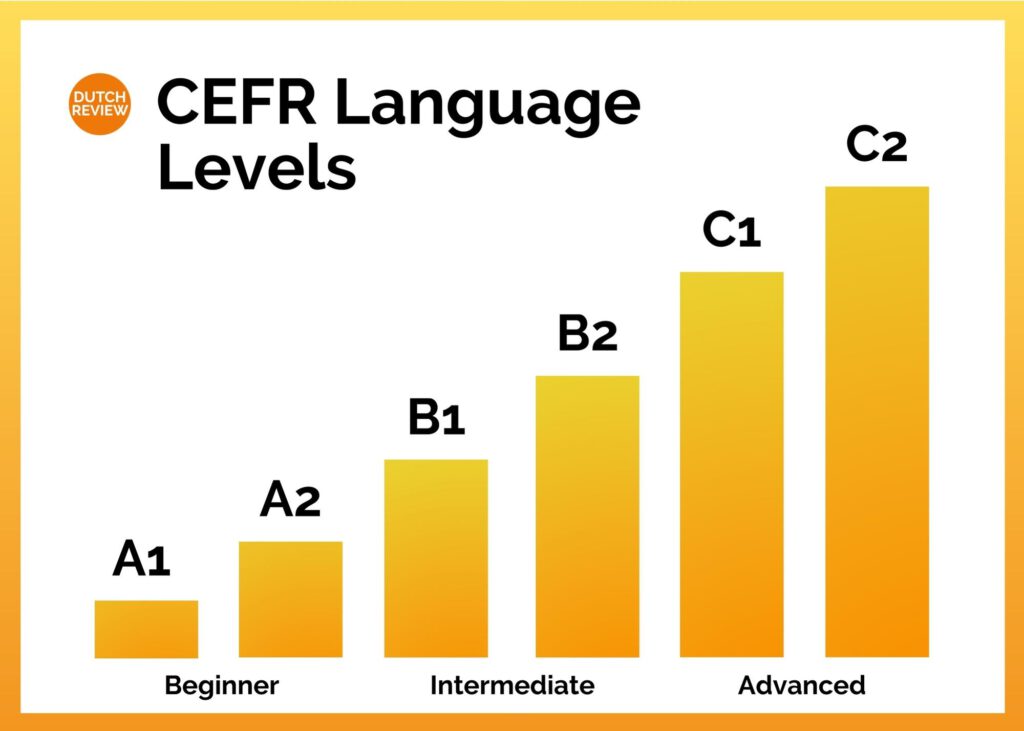Is 2025 the year that you will finally learn Dutch? The year that you will finally move from “Ik spreek een beetje Nederlands” to fully fluent?
Believe me: I know all the challenges of learning Dutch.
✅ I’ve tried the apps, listened to the podcasts, watched the videos, and attended the schools.
✅ I’ve read books, poured over textbooks, and drilled flashcards until my eyes couldn’t stay open.
✅ I’ve spoken with Dutchies, made mistakes, and been forced to revert to English even when I didn’t want to.
At the end of all that, I can confidently say: learning Dutch isn’t easy
Regardless, learning Dutch is possible. Thousands of internationals in the Netherlands have successfully mastered the tongue-twisting language — and so can you!
But you don’t even have to master it: Dutchies will appreciate any amount of Dutch you learn because it shows great respect for their country.
Plus, if you’re choosing to learn Dutch, you’re already doing better than everyone on the couch. 💪
READ MORE | How to stay motivated (and stop procrastinating) while learning Dutch
💭 Why learn Dutch?
Whether you’re living in the Netherlands, planning an extended stay, or just coming as a tourist, it’s well worth learning some Dutch. But the most common question both Dutchies and foreigners ask is: why learn Dutch when everyone in the Netherlands speaks perfect English?
READ MORE | Things people ask when you say you’re learning Dutch
We’ll be frank: it’s true that there is almost no need to learn Dutch. People from the Netherlands are truly excellent at speaking English and are consistently ranked as some of the best non-native English speakers in the world.
But, understandably, the Dutch still feel a strong attachment to their own language. While a Dutchie will happily switch to English to speak with you, they’re typically more comfortable in their native tongue.
So can you speak English in the Netherlands? Absolutely. But should you rely on it entirely? Definitely not.
Learning some level of Dutch (even if it’s just a few phrases to make someone smile) is a nod of respect that you’re a visitor in the Netherlands or a jump forward to becoming a Dutchie yourself!

Ready to leer Nederlands (learn Dutch)? I’ve chatted with the best non-native Dutch speakers, spoken to the masses, and trawled the internet for the best ways to learn Dutch. Laten we gaan! (Let’s go!)
🧩 Making sense of the Dutch language
Before leaping into the journey of learning Dutch, let’s take a quick look at what you’re getting yourself into.
⚖️ Differences between Dutch and English
You may know that there are some English words which have their roots in ye olde Dutch. Words like “boss”, “bluff”, “cookie”, “Santa Claus”, and even “Yankee” all trace their origin to Dutch — and that might be the reason why some people say learning Dutch is easy if you already speak English.
READ MORE | Ovens, uncles, and courage: English expressions with the word “Dutch”
Although both Dutch and English belong to the West-Germanic language family, there are a lot of differences between the two. Let’s take a look at a few:
Definite articles
Often, one of the first things people notice when starting to learn is that there are two definite articles in Dutch. Dutchies use either de or het, contrary to English which only has one definite article: “the.”
For learning Dutch, this means you’ll have to memorise not just the nouns but also the articles they pair with — fun!
Pronouns
Once again, why use one when you can have two? In Dutch, there are two forms of the personal pronoun “you.” For informal use, Dutchies say je, and in a formal situation, they go with u.
See if you can notice the difference between alsjeblieft and alstublieft next time you’re out! 👂
Word length — and this is no joke
You may have noticed that some Dutch words are super long. 😅 In fact, almost any Dutch word can be made as long as you want.
The Dutch language allows for virtually endless compound words, meaning that you can jumble words together in one endless stream.
That’s what happened when the word kindercarnavalsoptochtvoorbereidingswerkzaamhedencomitéleden (children’s carnival parade preparation work committee members) snatched a place in the Guinness Book of World Records in 2011. Phew!

However, for a word to be recorded in a Dutch dictionary, it must be in common use (thank goodness!). In the Dictionary of the Dutch Language — which is believed to be the longest dictionary in the world (we sense a pattern here) — the longest word is levensverzekeringsaangelegenheden (life insurance matters).
Is it difficult to learn Dutch?
Searching the depths of the internet while procrastinating studying the actual language (don’t worry, we’ve all been there), you’ll read that Dutch is pretty easy to learn.
Yup, based on linguistic similarities, Dutch is supposedly one of the easiest languages to learn if you have a Germanic language background (like English). 👀
However, DutchReviewers on our Instagram beg to differ. When asked about their adventures with the Dutch language, only 18% said they found it makkelijk (easy). The remaining 82% voted that Dutch was difficult to learn.
How you’ll fare with the Dutch language is hard to predict, though. So, our advice is to just get cracking and try to have fun!
Dutch dialects
If you’re one of the many people who find Dutch difficult to learn or worry about your pronunciation, rest assured that you don’t have to sound exactly like your Dutch neighbour: Dutch is a rich language with many dialects — and even some Dutchies’ pronunciation differs from the “standard.”
In the Netherlands, there are three regional languages that are recognised by the European Charter for Regional and Minority Languages:
- Frisian (spoken in Friesland),
- Low Saxon (spoken in the east of the country), and
- Limburgish (spoken in Limburg, Belgium, and some places across the German border).
Did you know? Frisian is genetically closer to English than Dutch is!
Within these regions, there are even more dialects — some claim up to 267 — spread across the Netherlands.
And while the four main dialect groups are West Flemish, Hollandic, Brabantian, and Limburgish, you’ll even hear a difference between an Amsterdammer and an Utrechter — even though the cities are only half an hour apart!
Why is Dutch called Dutch?
In Dutch, the language is called Nederlands — so why don’t we call it “Netherlandish” in English?!
Well, in the Middle Ages, Dutch was called Dietsc or Duutsc. Historically, it’s very similar to “Deutsch” (AKA German) and even shares the same etymology — meaning “language of the people.” ✊
The language was spoken colloquially, but not officially. Instead, the language of the church, education, and administration was Latin.
Similarly to why the Dutch people are called Dutch, the language of the Netherlands came to be known as Dutch once it slipped into English use. The English heard “Duutsc” and decided to call it Dutch. 🤷♂️
Dutch for the deaf? Interestingly, the Dutch Sign Language (Nederlandse Gebarentaal) has only been officially recognised as a language in the Netherlands since July 2021. It has tens of thousands of signers, so if you want another language challenge… this is your sign!
🏁 How to start learning Dutch
Now that you have an overview of the Dutch language, let’s begin taking steps towards learning it! These are the tips, tricks, and just general information that I wish I’d known when starting to learn Dutch:
Understand the Dutch language proficiency levels
When looking into Dutch courses, you’ll usually see them organised in terms of CEFR levels. CEFR stands for the Common European Framework of Reference and divides language proficiency (including Dutch) into six levels, based on spoken interaction, spoken production, listening, writing, and reading:

Generally, it takes between 100-200 hours to advance between the levels, but if you’re unsure about your level, you’ll find a bunch of free Dutch tests online that follow the CEFR framework.
Many Dutch language schools will also offer an intake class to determine your level.
READ MORE | How long does it take to learn Dutch?
If you’re worried about making it to the advanced levels, know that you don’t have to be at a C level to speak Dutch in your daily life.
Likely, you’ll already be able to hold a basic conversation at A2 and a more complex conversation around B1.
Define your Dutch learning goals
Next up, it’s time to kickstart your learning! To know what you’re working towards, I’d advise you to start by defining a goal:
- Do you want to reach a certain CEFR level?
- Perhaps you want to pass the integration exam?
- Or maybe you hope to carry out a conversation in Dutch when you meet your Dutch partner’s parents?
Whatever ambitions you have, we suggest writing them down to keep yourself accountable and referring back to them to see the progress you’ve made whenever you feel stuck.
We tend to be too hard on ourselves, so remember to give yourself some credit too!
Choose your Dutch learning strategy
Defining your study strategy is crucial to making real progress. Consider whether you are a visual, aural, verbal, or kinesthetic learner and focus on ways of learning Dutch that complement your learning style.
If you’re unsure about the best ways to learn Dutch, we’ll get to that in a jiffy. 👇
However, the most important thing when it comes to strategy is to give yourself time. Although we all want to learn Dutch fast and easy, it won’t happen overnight — so be gracious with yourself and remember to have fun.

Common mistakes when learning Dutch
Learning a new language can be exciting and challenging — but also intimidating. To learn, you have to leave your comfort zone and, yes, make mistakes.
Since we’ve certainly made our fair share of them, these are some common mistakes to look out for when learning Dutch:
False friends in Dutch
As you’ve probably noticed, Dutch borrows words from many different languages (think English, German, and various Scandinavian languages).
This is really awesome when you suddenly recognise a word like water and quite rightly translate it to, well, water.
However, it’s less fun when you realise that slim doesn’t mean slim but smart. That raar means weird and not rare, and that a wild rooster isn’t a wild rooster at all…but a cattle grid — excuse us?
We could go on, but you get the point — there are a lot of false friends between Dutch and English.
Even if English isn’t your native tongue, you want to stay alert when it comes to false friends: Imagine the surprise of a Dane (me!) when seeing vrede written on countless Dutch churches — thinking that it means “anger” (vrede in Danish) while in reality, it means peace.

Burning out
Another less technical mistake when beginning to learn Dutch is to try to do everything at once. However excited you are to master the guttural Dutch ‘g’ and flaunt your ability to say “Scheveningen” like a local, you can’t do everything at once.
A lot of people go all in the first few weeks of learning Dutch but then give up because they get overwhelmed. You simply can’t use all the apps, read all the books, speak every day, and also keep up with, you know — life in a whole new country.
So, look through the ways of learning Dutch below, pick one or two, and start from there. It’s more important to make slow, continuous progress over time than to burn yourself out and sacrifice your motivation to learn.
Not using your Dutch
The best thing that could’ve happened to my Dutch skills was when I started a job that involved customers. Although I had previously learned some Dutch grammar and vocabulary, I always struggled to bridge the gap between theory and practice.
Well, from one day to another, thanks to my side hustle at H&M during my studies, I had to talk to Dutch people on a regular basis. And let me tell you: it was terrifying. But it made me progress like I had never before.
The bottom line here is: as soon as you feel confident enough, please use your Dutch. Don’t make the mistake of learning all that grammar without putting it into practice. 🙅
🔝 The best ways to learn Dutch
Ready, set, go! These are our tried and tested ways of learning Dutch — gathered from my own experience, passed on by teachers and previous learners, and recommended by other DutchReviewers.
📱 Use an app to learn Dutch
Want to learn Dutch? There’s an app for that! Well, actually, there are quite a few. But, a word of caution first: it’s widely accepted in language-learning communities that using an app is a great way to start learning a language — but not the way to master one.
Therefore, use the apps below as a way to learn some great new vocabulary and inspire a love of learning this beautiful (??) language. You’ll learn some words and basic phrases but won’t delve into grammar too much.
So, what are the best apps to learn Dutch? We’ve collected our top recommendations for you below.
- Duolingo will teach you the most random but still somehow useful words to get you started on your Dutch journey.
- Memrise is similar to Duolingo but often has more relevant content, and their free version is really handy!
- Babbel has a free trial period that lets you get started with Dutch.
- Drops is perhaps the most fun and addictive (!) way to memorise Dutch vocabulary through illustrative games and personalised learning.
- Learn Dutch. Speak Dutch by Mondly requires just five minutes of practice a day.
- 6000 Words allows you to learn with fun language games and a visual approach.

🏫 Attend Dutch language schools
Get your books out and your glasses on because we’re going back to school! 📚
If you’re truly committed to learning Dutch, an app will only get you so far — and attending a school is the next step towards proficiency!
So, how do you decide which course to sign up for? In the Netherlands, you can choose between private language schools, municipality courses, university courses, and public library courses.
Private language schools
Are you ready to take your Dutch learning to the next level? Private language schools offer small class sizes and will teach you to read, speak, and understand Dutch — the whole shebang.
With private language schools, you can also choose from different course schedules, such as day, evening, or intense courses.
However, the breadth also comes with a price tag, so make sure you do your research and find the best private Dutch school for your needs!
TIP: Find the top picks fast with our ultimate list of Dutch language schools.
💶 Average price: €400-800 (solo lessons will be €1000+)
⏱ Typical length of courses: 8-12 lessons, generally once or twice per week.
🎯 Target group: All levels and age groups. There’s a course for everyone!
Municipality and public library courses
At the other end of the scale, municipality and public courses are cheap or even free but can be less well-organised than private schools.
Many library courses are centred around speaking Dutch (which is perfect if you don’t get to practice much in your everyday life!).
They offer a comfortable group setting, sometimes provide koffie and thee, and they let you speak with other internationals who are learning the language.
💶 Average price: Free, or a small contribution.
⏱ Typical length of courses: Weekly classes are on offer, but there is no fixed course schedule.
🎯 Target group: People with some (limited) level of Dutch who want to practice their speaking skills.
University courses
Finally, don’t overlook university courses! They aren’t only for students (though students are given a reduced fee) but are open to anyone who wants to learn Dutch.
As they’re part of the university, these courses follow the academic calendar or sometimes even the general Dutch holiday calendar (giving you, for example, an autumn break from the course).
The price level depends on what type of course (for example, an evening, intense, or integration exam preparation) you want to enrol in and whether you are a student or not.
💶 Average price: €200-700 per module
⏱ Typical length of courses: 3-4 months
🎯 Target group: All, but there’ll likely be a majority of university students in class.
💻 Sign up for online Dutch courses
On the hunt for a structured approach to language learning but don’t have time to attend a language school? Geen probleem!
Taking a MOOC can really help kickstart your study and is also one of our top recommendations if you’re on the hunt for free ways to learn Dutch!
MOOC stands for ‘Massive Open Online Course’ and is a great way to take well-organised classes in your own time. All it requires is a stable internet connection and a dose of self-discipline.

For beginners, we recommend the three-week introductory course offered by the University of Groningen. This course is completely free (unless you want a certificate of completion), teaches you the basics of Dutch and Dutch grammar, and is a great way to kickstart your language learning.
Alternatively, check out Learn Dutch with Bart de Pau or the ‘Dutchies to be’ online course: Learn Dutch with Kim. Both provide well-structured and entertaining online courses, some free and some paid, in addition to free (and super helpful) YouTube videos.
📙 Use textbooks to learn Dutch
Are you a motivated self-studier who wants to go beyond vocabulary? Then using textbooks to learn Dutch could be the next step towards proficiency!
So, if you’re ready to dabble in a bit of grammar, get yourself to any major bookstore in the Netherlands and peruse their selection of Dutch textbooks. Some of the most popular ones include ‘Nederlands in gang,’ ‘De opmaat,’ and ‘Contact!’.
Although you’ll miss out on speaking practice, you can readily go through the textbook chapters and exercises in your own time. Most Dutch textbooks also include online exercises that are super helpful.

Reference books to support your Dutch learning
- Essential Dutch Grammar: An oldie but a goldie. Focusing on the grammar needed for everyday Dutch communication, this book is written for the adult language learner with limited time.
- Dutch Verb Conjugator: The most common verbs fully conjugated: The ultimate overview of Dutch verbs. Organised alphabetically, this book will provide you with exactly what it promises: the most common Dutch verbs, fully conjugated.
- The New Routledge & Van Dale Dutch Dictionary: Dutch-English/English-Dutch: This dictionary is a classic in the Netherlands. If you’re not into googling everything, this will be your best friend when looking up words.
- Basic Dutch: A Grammar and Workbook: An easy-to-use guide for learning the essentials.
Tip: There are some fictional stories written specifically for Dutch learners that help you out with tricky words. We like ‘Short Stories in Dutch for Beginners’, ‘Dutch Short Stories for Beginners’, and ‘Conversational Dutch Dialogues’.
🧑💻 Join online communities to learn Dutch
Another free and often seriously fun way to learn Dutch is by joining online language learning communities.
In fact, they don’t even have to be focused on language learning! Sometimes, flexing your Nederlands is just easier in the less confronting space of the internet.

So, power up your laptop and join a Discord, Reddit, or Duolingo community because there are plenty of servers and subreddits for you to explore.
Some are created explicitly for internationals to practice their Dutch, some are multilingual communities that are happy to communicate with you in Dutch — and others are just waiting for you to share the best Dutch memes with them.
Tip: We recommend the ‘Official Unofficial Duolingo Discord’ with a channel for every language course on Duolingo!
🎧 Listen to Dutch podcasts and songs
If you follow an English-taught study or work in an international company, you may not get many chances to finetune your ears to the guttural sound of the Dutch language. One way to do this is by listening to Dutch podcasts and songs!
Listening to podcasts in Dutch is a great way to learn conversational Dutch and, depending on what podcast you select, familiarise yourself with Dutch history and culture at the same time.
To make your search easier, we’ve gathered nine podcasts that’ll have you speaking Dutch in no time.
Now, if you’re trying to find a way to make the (dare we say harsh?) Dutch language a little more melodic, then grab your headphones and get ready to sing along with Dutch songs to learn the language (and culture!). Have fun! 💃
📹 Watching videos to learn Dutch
Watching videos is another awesome way to practice your Dutch listening skills. On YouTube, you’ll find specific Dutch language learning channels, but there are also other Dutch Youtubers that’ll make you learn the language fast.
So, whatever YouTube loop you tend to be sucked into — be it lifestyle and health channels, gaming, comedy and experiments, or news and educational content — you’ll find a Dutch version out there! Might as well turn that procrastination into learning. 🧠
READ MORE | 21 YouTubers that’ll help you learn Dutch super fast
🗣️ Talk with Dutchies
You can listen, read, and do grammar exercises all you want, but in the end, if you want to really learn Dutch, you need to practice speaking it. (And get Dutchies to speak Dutch with you).

Trust us, we know it’s scary. You’ll stumble, make mistakes, and sometimes conversations will even break down, and you’ll have to recover in English.
READ MORE | Like a native: 21 ways to elevate your everyday Dutch phrases
However, if you practice your Dutch regularly, then you’ll see improvements with every conversation — and before you know it, you’ll be flying through the five stages of learning Dutch!
📼 Watch Dutch TV shows and movies
Sometimes, you’re just not in the mood to pour over a book, listen attentively to a podcast, or even socialise — and that’s okay.

But guess what? You don’t need to do any of those things to learn Dutch.
Indeed, you can improve your Dutch while sitting on your couch! All you need to do is turn on the TV (or computer).
READ MORE | 7 series and films on Netflix to help you learn Dutch
Depending on your mood and level of Dutch, you can watch a Dutch TV show or movie with English subtitles or perform your usual binge with Dutch subtitles!
Netflix and Dutch language learning
Okay, so you’ve set your subtitles to Dutch, watched all the Dutch movies on Netflix, and perhaps even discovered the many free shows and movies available on the Dutch broadcasting site NPO Start.
Now, it’s time to add the extension Language Reactor (previously called Language Learning with Netflix) to your Google Chrome browser and level up your couch potato-ing. The extension allows you to watch Netflix with two sets of subtitles running at once. 👯♀️
Using Language Reactor, you can compare the Dutch audio and text to a translation in your language. The extension also highlights the most important words in the subtitles and offers you a pop-up dictionary — pretty neat if you ask us!

👬 Join a (mostly) Dutch-speaking club or association
Do you already have some of the basics in place and are ready for a deep dive into the Dutch language and culture? Then ask your local football team, yoga studio, rowing club, sewing circle, or student association if they’re happy to have an international join.
Some will require fluent Dutch, but others are happy to do a little extra explaining if you don’t understand everything they’re talking about.
It takes courage, but immersing yourself in the Dutch language is a guaranteed way to learn fast while also enjoying a hobby and getting to know some Dutchies.
💪 Flexing your new language skills: using Dutch in your everyday life
Goed gedaan! (well done!). You’ve studied, stumbled, and learned — and are now ready to share your language proficiency with the world. 🎉
Alright, perhaps you just start with your Dutch friends, but using your Dutch regularly is the key to maintaining it (and becoming more comfortable speaking it!).
Sometimes though, that’s easier said than done.
How to get Dutchies to speak Dutch with you
Getting Dutchies to speak Dutch with you can be more tricky than it sounds (and should be). It’s not that they want to be rude or dismiss your efforts — they just likely won’t think twice about switching to English.
After all, they’re some of the best non-native speakers in the world.
So, embrace the Dutch directness and simply insist on Nederlands praten (speaking Dutch). A great way to do this is to say:
“Ik leer Nederlands en ik moet oefenen.”
(I’m learning Dutch and I need to practice).
🎩 Top Dutch learning tips
With all of those different ways of learning Dutch in mind, you may need some tips and techniques to stay on top of everything. These are the ones we’ve benefitted from:
- Focus on a few things at a time: While enthusiasm is great, learning Dutch takes time, so pick one way of learning and stick with that for a while rather than trying to do everything at once. It’ll be more enjoyable, and you can more easily see what learning techniques work for you.
- Go crazy with the sticky notes: Use sticky notes to learn the Dutch names of the objects you see every day. Stick them on your kitchen cupboards, wardrobe, and bookshelf — basically around your entire home — and you’ll be familiar with the translation of household objects in no time!
- Hang a grammar table on the back of your toilet door: Grammar might be one of the most universally dreaded parts of learning a language. So, know yourself and put a table of Dutch conjugations on the back of your toilet door so you practice when you have nothing else to do — and literally can’t run from it.
- Find a friend to message in Dutch: Sometimes, busy schedules get in the way of meeting with friends to practice Dutch. It happens! However, it doesn’t have to come in the way of learning the language. Simply text your Dutchie friends in Dutch! They’ll be happy to help, and you’ll pick up some Dutch slang and abbreviations.
- Read the newspaper: Pick up the Metro newspaper next time you’re sitting in the tram to practice reading Dutch or check out the NOS Jeugdjournaal for news written in simple Dutch.
- Talk with non-natives who are also learning Dutch: Speaking to other Dutch learners, they will likely understand your stumbles and grammar better than Dutchies — and they’ll be more forgiving of mistakes.
🙋♂️ Frequently asked questions about learning Dutch
🏃♀️ Can you learn Dutch fast?
Depending on your level of commitment, study hours, and language background, you can learn Dutch relatively fast.
Looking at how long it takes to learn Dutch, it’s estimated that a native English speaker will need 5.5 hours of class lessons every week for two years to become fluent.
However, you don’t have to be fluent. If you’re aiming for a basic level of Dutch, you’ll get there much faster!
💻 Can you learn Dutch online?
Dutch language schools are becoming more skilled in online teaching, and many offer a variety of online courses. So yes, it’s definitely possible to nail learning Dutch online!
There are also a lot of free Dutch language resources online — Dutch proficiency doesn’t have to break the bank.
💰 Can you learn Dutch for free?
Yes! Learning Dutch for free is definitely possible, but it requires commitment and diligence. In fact, there are at least 16 free ways to learn Dutch for the passionate (or desperate) language learner on a budget.
😌 What’s the easiest way to learn Dutch?
Learning Dutch is a personal endeavour, and your way of learning will likely look different from someone else’s. In general, however, attending a Dutch language school is a great way to get a well-rounded learning experience — practising reading, writing, speaking, and listening on a regular basis.
📝 What level of Dutch do you need for the Dutch integration exam?
Currently, you need to have an A2 level of Dutch proficiency on the Common European Framework of Reference (CEFR) to pass the Dutch integration exam. That includes reading, listening, speaking, and writing. However, for people who receive notice that they must integrate in or after 2022, their requirement will be B1.
How’s your Dutch learning going? Have you used any of these ways to learn Dutch? Tell us in the comments below!






I’m learning Dutch during a year A2 level now. I have used this app https://play.google.com/store/apps/details?id=com.funifelt.Dutch listening a native speaker and playing some games help! highly recommended:)
I’m currently learning Dutch, whilst trying to not spend too much and I think this article is amazing. Thank you Christine for writing this engaging and very thorough guide.
Started learning Dutch today and this information is very helpfulThanks
By far, the best article out there. Thank you so much Christine. Namaste 🙂
You didn’t mention the best app Dutchpod101 i think they didn’t pay you for that toch
That is so rude of you, James.
And don’t forget to swear, in particular with religious connotations (G*********e), illnesses, (krijg de kanker, the tering, tiefus), and sexual (k*t dit, k*t dat).
Not sure that’s on an app though ;-D